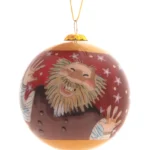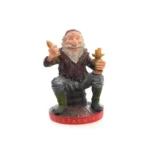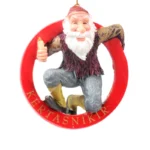Leppalúði - Grýla's Husband
“Leppalúði sat in the shadows, staring at the fire, never moving, unwilling to help Grýla with her task.“
– Inspired by Jóhannes úr Kötlum, Jólin Koma, 1932
Introduction
Leppalúði is the lesser-known but equally mysterious husband of Grýla, the infamous ogress of Icelandic folklore. Unlike his terrifying wife, who actively hunts down misbehaving children, Leppalúði is known for his lazy and unmotivated nature. He mostly stays in the background, content to let Grýla do the hard work while he remains in the cave, contributing little to the family’s wicked plans. Despite his limited role, Leppalúði is still part of the Yule Lad legend and serves as a darkly humorous contrast to his powerful wife.
Historical Background and Earliest Known Reference
Leppalúði’s earliest mentions appear alongside Grýla’s in the 17th-century folktales that describe the pair as trolls who feast on misbehaving children. His name, “Leppalúði,” translates roughly to “the Raggedy One” or “the Tatterdemalion,” a fitting description of his lazy, bedraggled appearance. While Grýla’s fearsome deeds are at the forefront of the legend, Leppalúði is often described as merely her ineffective companion, lacking the drive and determination to act on his own.
Though he is overshadowed by his wife and sons, Leppalúði remains an important figure in the stories as the patriarch of this strange family. His character represents a figure of passive menace, who benefits from the work of others while remaining largely inactive.
Physical Appearance and Clothing
Leppalúði’s physical appearance matches his lazy and ragged personality. He is often depicted as a tall, gaunt figure with a scruffy beard and clothes made from patched-together rags and old furs. His clothing is usually torn and tattered, reflecting his lack of care for his appearance and his idle nature. In some versions of the story, Leppalúði is portrayed as much older and weaker than Grýla, with his hunched posture and shabby clothing giving him a more pitiful look compared to his fearsome wife.
Unlike the other characters in the Yule Lad legends, Leppalúði’s role is more symbolic than active, and his appearance is often used to emphasize his laziness and lack of energy.
Likes, Dislikes, and Habits
Leppalúði’s defining trait is his laziness. While his wife, Grýla, goes out in search of children to cook, Leppalúði prefers to stay behind, idly lounging in the cave and doing very little to contribute. He enjoys a life of inactivity and relies on Grýla to provide for him, making him a passive figure in the folklore. His habits are simple—he spends most of his time resting, eating the stew that Grýla prepares, and avoiding any kind of work or effort.
He dislikes having to exert himself, and his lack of ambition sets him apart from the more active and dangerous figures in the legend. His indolence is his defining characteristic, and he is often portrayed as a burden rather than a help to Grýla.
Types of Pranks and Mischief
Unlike the Yule Lads and Grýla, Leppalúði does not actively engage in pranks or mischief. His main “prank,” if it can be called that, is his laziness—he simply doesn’t do much of anything. His role is more of a passive menace, lurking in the background while his family carries out their deeds. He doesn’t hunt for children, nor does he play tricks; instead, he benefits from the hard work of his wife, enjoying the spoils without putting in any effort.
In some versions of the story, his laziness is played up for comedic effect, with Leppalúði shown as being comically useless, even in the face of Grýla’s ferocity.
Relationship with Humans and Other Yule Lads
Leppalúði’s relationship with humans is minimal, as he rarely interacts with them directly. He is content to remain in the shadows, letting Grýla handle the dirty work. While the Yule Lads venture out each night to play their mischievous pranks, Leppalúði stays behind in the cave, living off the spoils of their and Grýla’s efforts. His laziness makes him an almost comical figure when compared to the active pranks of his sons.
His relationship with Grýla is one of dependency—he relies on her for food and survival, and while he is her husband, he does little to support her beyond his mere presence. The dynamic between them reflects a contrast between action and inaction, with Grýla as the driving force of their partnership.
Modern Depictions and Popularity
Leppalúði is not as popular or well-known as Grýla or the Yule Lads, and his role in modern depictions of Icelandic Christmas folklore is often downplayed. However, when he does appear in stories or holiday decorations, he is typically portrayed as a comic figure—a lazy, bedraggled husband who spends his days doing little while his fearsome wife takes care of everything. His appearance in children’s books and holiday events often serves to highlight Grýla’s power and the strange dynamics of their family.
Fun Facts and Trivia
- Leppalúði’s name, meaning “Raggedy One,” reflects his shabby appearance and lazy demeanor, as he is often shown wearing tattered clothes.
- In some versions of the folklore, Leppalúði is depicted as being much older and weaker than Grýla, making him appear even more passive in comparison to his terrifying wife.
- Despite his laziness, Leppalúði is often portrayed as Grýla’s loyal, if useless, companion, content to let her handle the hard work.
Astrological Sign: Pisces
Leppalúði’s passive nature and tendency to drift through life without much effort align well with the traits of Pisces. Known for their dreamy, laid-back approach to life, Pisceans can sometimes be seen as avoiding responsibility or preferring to live in their own world. Leppalúði’s reliance on Grýla to handle their affairs and his preference for a life of leisure make Pisces a fitting astrological sign for him.
Cultural Significance
Leppalúði’s character represents the opposite of the active, threatening figures of Icelandic folklore. His laziness and passivity contrast sharply with Grýla’s terrifying pursuit of naughty children, adding a darkly humorous element to the legend. His character serves as a reminder that not all figures in folklore are heroes or villains—some are just content to do nothing at all.
“In the shadows of Grýla’s cave, Leppalúði lingers—silent and idle, as his fearsome wife carries out their dark deeds.”– Traditional Icelandic Proverb
Leppalúði’s presence in Icelandic folklore adds a touch of absurdity to the otherwise fearsome legend of Grýla and the Yule Lads, showing that even in the darkest stories, there can be moments of humor.
Voices of Tradition
“Leppalúði sat í skugganum, horfandi á eldinn, en hreyfði sig aldrei, án þess að hjálpa Grýlu með verkefni hennar.“
Inspired by Jóhannes úr Kötlum, Poet




